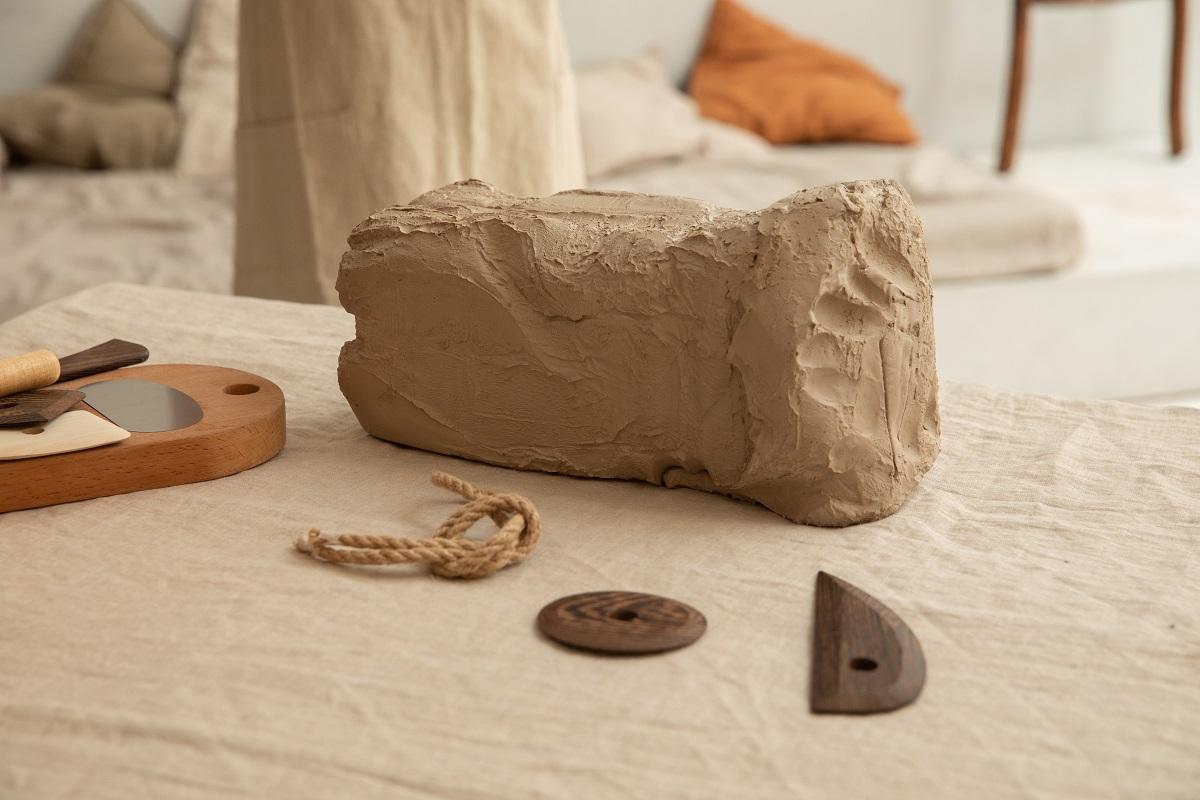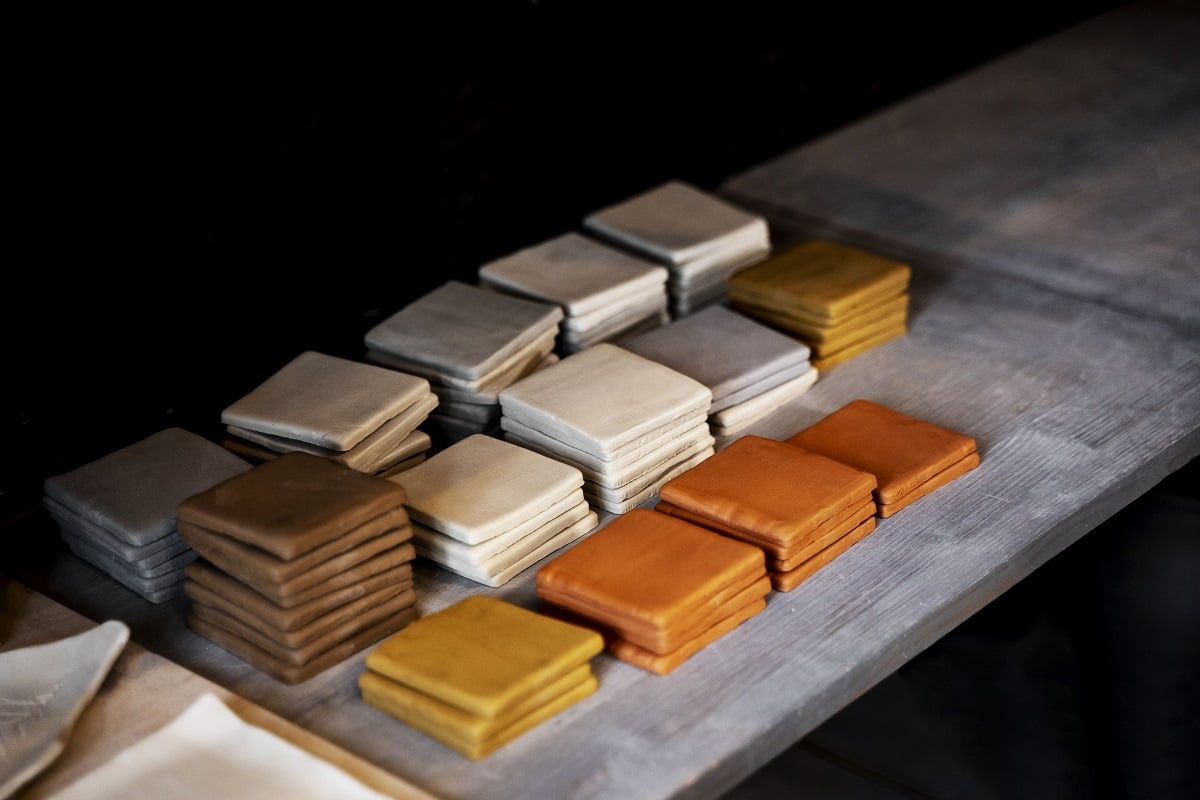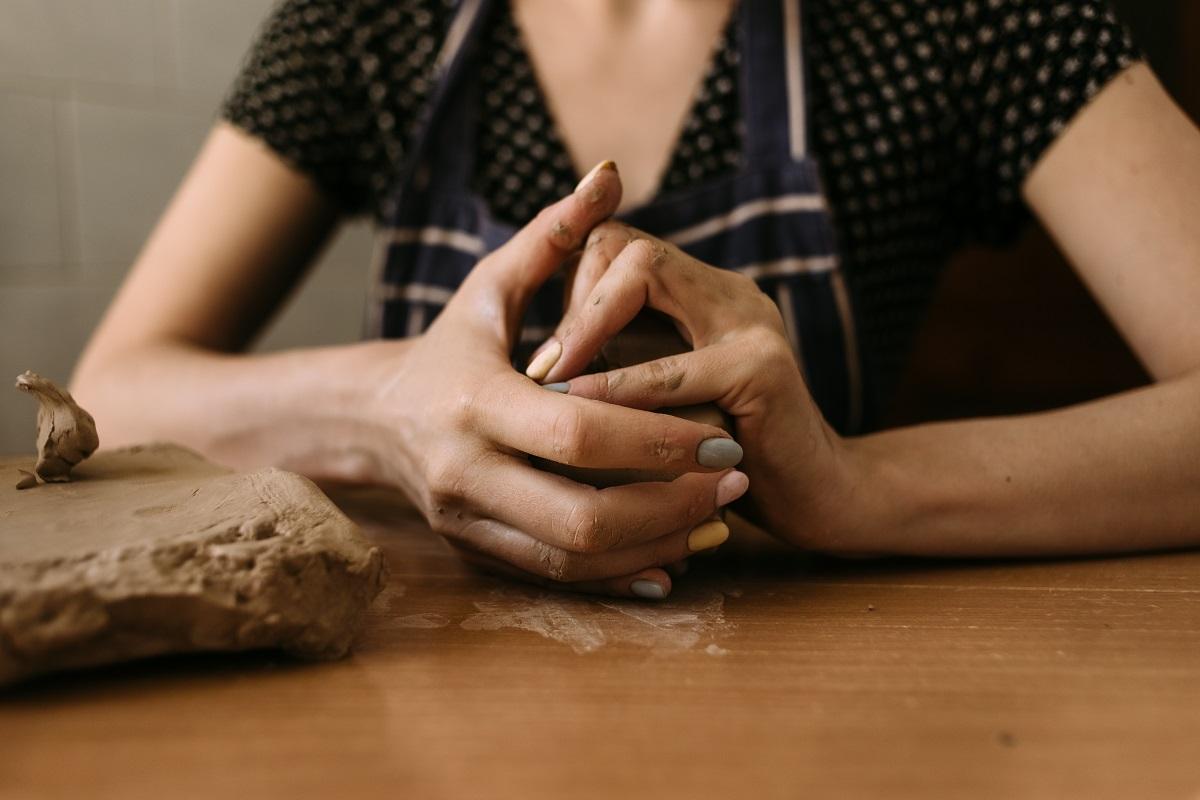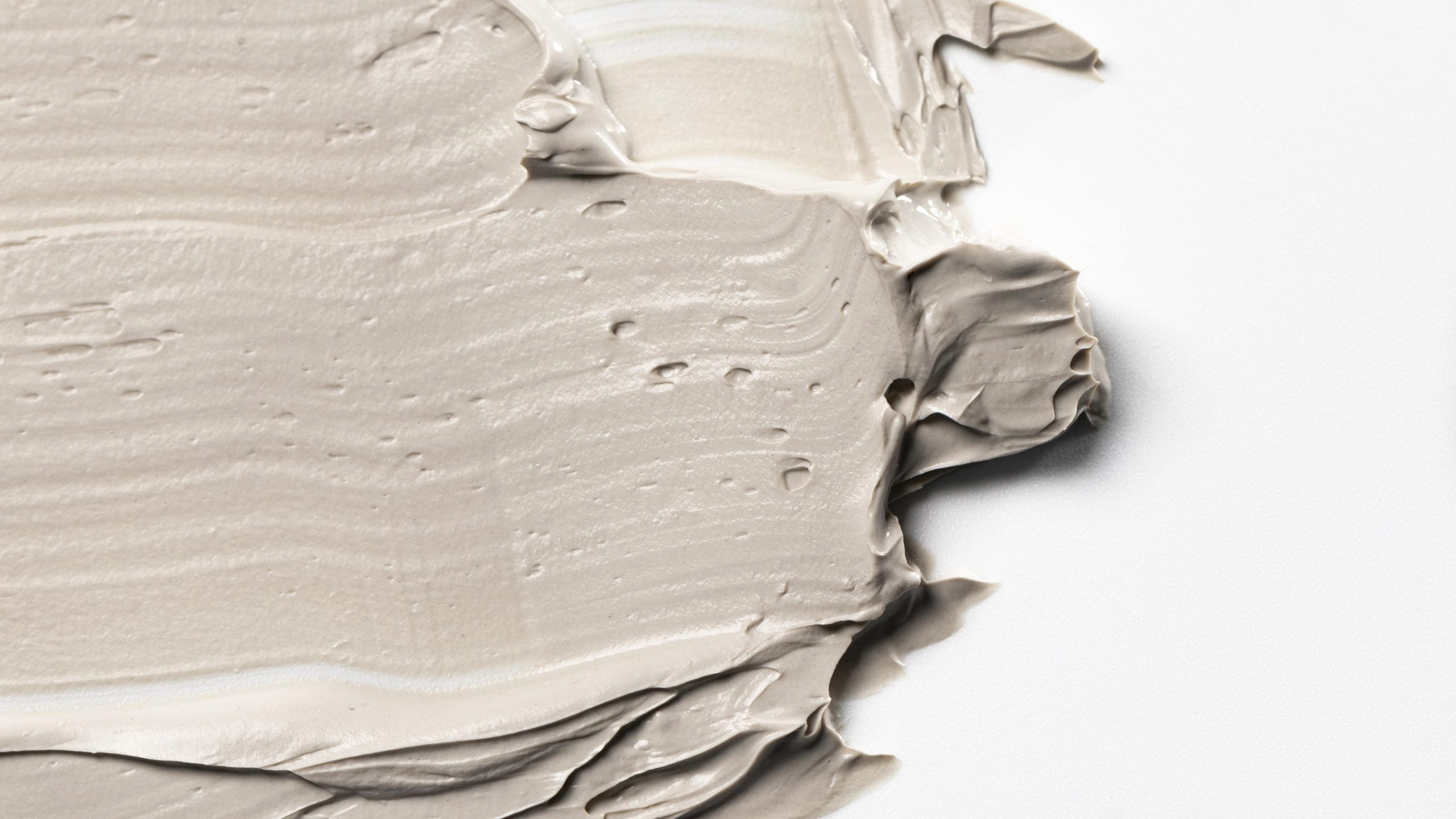When it comes to art forms like sculpting and modeling, selecting the best clay for sculpting is crucial for success.

This is because not all clay is suitable for the different types of sculpting purposes, due to their varying chemical compositions. Each type of clay is meant for a specific application. And, knowing about the various types can help you select the most suitable clay for any purpose.
While one type of clay may be suitable for sculpting, another one might be ideal for pottery. That’s why if you’re planning to try out any of these art forms yourself, the first thing to do is learn all about the different types of clay.
In this guide, we’ve explained the various types of clay and their uses to make things easy for you. Armed with this knowledge, you can get started on your sculpting journey quickly. So, let’s dive in!
Some Terms Related To Clays

Before looking at the various types of clays that can be used for sculpting and pottery making, it is crucial to understand some basic terms related to them.
1. Plasticity
The plasticity of any clay refers to its flexibility which allows it to be molded into various shapes. That is why art forms like pottery that use mediums like clay are often called plastic arts. The plasticity of any clay generally depends upon its ability to hold water, the size of its particles, and its age.
Selecting the clay with the right plasticity type is vital and will determine how easy it is to work with. Most clays have an adequate level of plasticity and will not crack on pushing, bending, or pulling, but this property wears off after the clay is fired.
2. Ceramic
Ceramic refers to a solid sculpted body that has lost its plasticity after being fired. Such materials are hard, brittle, and corrosion-resistant. After the clay is fired, it melts and loses its retained water and also releases some gasses. This helps the clay particles form very strong bonds, leading to the formation of ceramic.
Clay Compounds
Different types of clays have various compounds that affect their nature and properties. These include:
1. Kaolinite
Kaolinite is a white-colored earthy, soft clay mineral that may have a rust-like hue and is present in all types of clays. It is an inelastic silicate compound produced by the chemical weathering of materials like feldspar.
2. Smectite
Clay minerals that contain varying amounts of alkaline earth metals and alkali metals are known as smectite. These minerals are good at absorbing water and can expand easily.
3. Chlorite
Chlorite contains varying quantities of calcium, lithium, zinc, magnesium, manganese, and nickel. While it is not considered a clay compound, it is present in certain types of clay as a mineral.
4. Illite
Illite contains elements like iron, magnesium, aluminum, silicon, and potassium and is a non-expanding mineral. At times, it may also contain chromium and sodium. Unlike other clay minerals, illite is found in the form of small particles and is a rocky compound.
What Is Sculpting Clay
Clay is a soft form of earth that can easily be molded into different forms due to its plastic-like consistency, which is used to create different objects. However, it needs to be hardened using a process called firing to sculpt hard objects. Other materials like salts and minerals are often added to it to provide it with different colors and textures.
Also, clay tends to change its appearance after firing, acquiring a different texture and color depending upon its nature and the firing temperatures.
For any clay to be suitable for sculpting purposes, it should possess certain characteristics. Firstly, it should not contain sand and rocks and should have a smooth texture. Plus, it should be reasonably flexible while offering an adequate level of sturdiness for making sculptures.
Finally, sculpting clay should not be affected by heat shock.
Main Types Of Sculpting Clay

Sculpting is an art form that involves shaping, carving, or casting a moldable material. While several materials can be used for sculpting, clay is the most popular one. But, there are many different types of clay, each suitable for a specific purpose. The main types of sculpting clay include:
1. Water-Based Clay
Water-based clay is mixed with water and is among the most affordable types of clay. It is easy to work with, mainly because it dries quickly as the water evaporates. This clay was first used to create Disney animatronic models, and is hence known as WED clay.
Water-based clay is most suitable for small projects due to its fast-drying nature and can be kiln-fired to provide the finished sculpture with rigidity. It remains usable for a long time if stored properly in a sealed bag.
However, you need to ensure that it has adequate moisture, as loss of water content can cause it to shrink over time.
Air-Dry Clay
Air-dry clay is the most common water-based clay, and as the name indicates, it can be dried easily using ambient air. It does need to be kiln-fired since it cures in the air, and there is no need for exposure to high temperatures.
This type of clay is commonly used as modeling clay, and the time it takes to dry depends upon the thickness of the sculpture created. What’s more, it does not require any special sculpting tools and can easily be colored using marker pens, acrylic paint, and tempera.
Air-dry clay is generally used for projects that do not require a lot of detailing and is a popular medium for arts and crafts projects.
2. Oil-Based Clay
Oil-based clays are made using various waxes, oils, and clay minerals. Unlike water-based clay, oil-based clay does not dry out even in extremely dry conditions. Also, sculptures and objects made from this type of clay are not ceramics and cannot be fired.
Animation artists generally use this type of clay since it can be reused, but its malleability depends upon the temperature, which determines the viscosity of the oil. Oil-based clays are ideal for sculptures and objects that have fine details, but such clays are quite expensive.
Such clays can be used for making silicone molds if they are free of sulfur. Some common oil-based clays include:
A. Plasticine
Plasticine is an oil-based clay that includes a binder-like clay flour along with oil and clay. First developed by William Harbutt, an art teacher, plasticine is the trademark name of this type of clay. It is soft and workable, unlike water-based clay, and is available in several colors, but it often contains sulfur, making it unsuitable for silicone molds.
Plasticine is the best option for modeling since it remains soft and workable for a long period without sticking to your hands or working surfaces. And, you can blend different colors of plasticine to create new shades. Another advantage of this clay is that it can be used to create highly detailed sculptures but should not be exposed to high temperatures as it can melt easily.
B. Epoxy Clay
Epoxy clay contains epoxy resin and epoxy curing agent and does not harden as long as the two components remain separate. When combined, an exothermic reaction leads to the curing of the clay, which can take between two and three hours. While this type of clay is available in various colors, the range is not as large as that of polymer clay.
Since epoxy clay hardens when the two components are mixed together, it does not need firing. But, it remains soft for a very short period after the resin and curing agent are combined. That is why it is unsuitable for projects requiring a lot of time.
Epoxy clay also forms very hard objects that do not crack or fade easily and can easily be painted using oil paint, acrylics, alcohol inks, and spray paints. You can also coat objects made from this clay with a UV protective layer to make the color last even longer. However, epoxy clay is one of the more expensive types of clay
C. Polymer Clay
Polymer clay includes several types of clays used for sculpting or modeling purposes. It is made from polyvinyl chloride (PVC) combined with lubricant, plasticizer, stabilizer, and various pigments. The pigments allow this clay to be available in a wider selection of colors than any other clay type.
When uncured, polymer clay forms a vinyl mixture which becomes solid vinyl upon curing. It has several advantages over other types of clay, such as being inexpensive and highly versatile. You also do not require special kilns or ovens to cure sculptures made from polymer clay, as it never dries out. So, there is no chance of it hardening while being used.
Moreover, all can use polymer clay, irrespective of their skill level, making it suitable for kids and even professional sculptors. Polymer clay can be used for several purposes, including fine jewelry pieces, large-scale sculptures, and decorative items.
It is also used in commercial applications and arts and crafts projects. However, due to its synthetic nature, you need to observe some precautions when working with it.
3. Dough Clay
Kids popularly use dough clay to create objects. It can easily be prepared using home ingredients like oil, water, cornstarch, cream of tartar, and flour. You can also use food color to dye it as required.
While it is a highly affordable option, it is mostly used by children to create temporary sculptures and objects since it cracks easily on drying. To prevent that, you can bake the finished sculpture in an oven.
4. Ceramic Clay
Ceramic clay is the most popular clay used for sculpting purposes. It is generally heated or baked, which provides the modeled object with a permanent structure. Unlike pottery clay, ceramic clay contains other minerals along with the clay itself. There are five different types of ceramic clays.
The Main Types Of Ceramic Clay

These are the main types of ceramic clay that can be used for your clay modeling ideas:
1. Earthenware Clay
This is the oldest type of clay that has been used for various purposes for centuries and remains one of the most common options even today. This clay usually has warm colors such as brown, red, and orange, which become apparent after the clay has been fired.
Terracotta is the most popular among earthenware clays and is commonly used for hand-building and sculpting to make flower pots and similar objects. The main reason for its red-orange color is that it is very rich in iron oxide, also known as rust. But earthenware clays can also be found in yellow, tan, white, or buff colors.
Another aspect of earthenware clay is that it appears coarser and more rustic than most other types of clay because it is more porous. When the clay is fired, the small particles or platelets in it move closer together.
Also, the clay body produces glass on being fired which expands to fill the spaces between the platelets and bonds them together. This process is called vitrification and is responsible for providing strength to the clay. Since earthenware clay produces less glass on being fired than other types of clay, the gaps between the various particles are larger, and the clay is more porous.
Uses
Being more porous than most other types of clay, earthenware clay is less dense and not as strong, breaking and chipping off more easily than porcelain or stoneware. That is why it is glaze fired, which makes the clay waterproof and suitable for dinnerware. This type of clay can also be used for outdoor decorations, sculpting, and other purposes.
Firing
Generally, different types of clay are fired twice during production, and the first fire is called bisque fire which makes them hard. The second fire is called glost or glaze fire. Most clays are bisque fired between 1830 and 1940 degrees Fahrenheit, and may remain porous even after that.
However, earthenware clays are fired at the lowest temperatures. They can absorb about seven percent moisture after firing. Earthenware clays remain soft and can be scratched easily since they do not become completely vitrified like porcelain clay or stoneware clay.
Also, this clay cannot withstand firing at high temperatures and can break or melt easily but can be glazed well, unlike many other clays. This process involves dipping, painting, or spraying raw glaze onto the bisque-fired clay, which hardens to form a glass-like layer and protects it from water.
2. Stoneware Clay
While earthenware clays are highly plastic and easy to work with, stoneware clays are harder and nonporous. They are fired at higher temperatures than earthenware clay as they can withstand higher heat and become incredibly tough and dense after firing. Stoneware clay is also more chip-resistant and can be used for several purposes, like sculpting and wheel throwing.
This clay may be gray, white, or brown when wet, with gray being the most prominent. The depth of the color can vary from pale gray to deep gray, and this clay can also contain elements like quartz, mica, and kaolinite. Smectite and Illite are often present in this type of clay and affect its color.
After firing, the color tends to lighten up, so it may also appear tan or beige. Stoneware that is used for commercial purposes generally contains highly refined particles, which provide it with a smooth appearance. But, the clay used by potters has a speckled look because of mineral impurities or due to the grog added to it to improve performance.
Grog is clay that is fired, ground up into granules, and then added back to the clay, reducing the chances of cracking and making the clay easier to work with. When made from larger granules, grog provides a grainy appearance to the clay.
Uses
Stoneware clay can be used with glazes, underglazes, overglazes, and enamels, making it ideal for tableware. It is also used in wheel throwing and hand sculpting. This type of clay has a higher quantity of glass-forming materials that melt when it is fired, making it more vitreous and less porous. Because of that, it is suitable for dinnerware and objects like vases.
Additionally, stoneware clay is less prone to chipping and breakage than earthenware and can be used for baking, cooking, and making garden sculptures.
Firing
The firing temperature of stoneware clay ranges from 2167 to 2345 degrees Fahrenheit. Fire clays like stoneware are refractory, which can withstand very high temperatures and are ideal for ceramics. This allows them to mature more properly during the firing process and provides the clay with a rougher surface due to mineral impurities like iron.
3. Porcelain Clay
Porcelain clay, also known as China ceramics, is a highly refined clay and is the most popular type of clay used for dinnerware. Another popular name for this clay is kaolin clay, mainly because it is created using pure mineral kaolin or China clay.
This clay has subtle and light colors, ranging from off-white to gray, and only requires glazing to provide color since it is already waterproof. Porcelain clay also tends to acquire a translucent appearance after being fired since it is made from very fine particles.
Since this clay has more of these particles than earthenware and stoneware clays, it can be used to design delicate pieces. Porcelain clay can be further subdivided into three types of clay:
1. Hard Paste or True Porcelain
This is the most common of all kaolin clays and usually contains mica or feldspar in addition to kaolin. It is fired at extremely high temperatures and used to create highly durable objects.
2. Soft Paste Porcelain
This ceramic clay is not very common and is made by firing the clay at lower temperatures. It is generally considered a weak clay and is prepared by mixing kaolin with glass, quartz, bone ash, and soapstone. Ball clay is also used for making this clay.
3. Bone China
Bone China is the modern replacement for true porcelain and is the strongest of all porcelain clays. It contains kaolin, feldspar, bone ash, and phosphates. Bone China is incredibly sturdy and does not chip easily.
Uses
Being the least plastic of all clay types, porcelain is not very easy to work with. It has to be fired at very high temperatures, which is why it is often mixed with other minerals. This lowers the firing temperature and makes the clay easier to use.
Porcelain is used for wheel throwing and cast slipping to create dinnerware and decorative objects like vases. This type of clay also has low porosity and is very dense but can be made to look refined and delicate. That is why it is a good choice for making sculptures.
And, due to its incredible sturdiness, this clay is often used in dentistry and mechanics.
Firing
Porcelain fires at temperatures above 2232 degrees Fahrenheit but is generally fired at temperatures over 2300 degrees Fahrenheit. Being a high-fire clay body, it matures at much higher temperatures than most other ceramics like earthenware or stoneware.
4. Ball Clay
Ball clay is the most plastic ceramic clay and contains very few mineral impurities. Generally sold in powdered form, this type of clay is often added to other types instead of being used as a clay body.
Ball clays contain a large quantity of quartz, kaolinite, and some amount of mica and occur as natural sediments or deposits. Sometimes minerals like lignite may also be present in it. But, the main thing distinguishing this type of clay from other clay bodies is its fine particle size, making it highly porous.
This is why ball clay is often added to other types of clay, like China clay, to make it easier to use. Additionally, this clay usually has a gray color but loses it on firing and acquires a light buff appearance. When fired correctly, it gets a white color which is ideal for pottery.
Uses
Due to very fine particles, ball clay is used to make terra sigillata, a clay slip that provides a high sheen to pottery. Being too fine to be used alone, it is popularly used for wheel throwing, slip casting, and as an additive to other types of clay. It is also used for toilet bowls, floor tiles, tableware, and vases.
Firing
Ball clays are fired at around 2345 degrees Fahrenheit but are very prone to shrinkage during this process. That is one of the main reasons why it is so hard to use them alone, and they are best used by mixing with earthenware or stoneware clays.
5. Fire Clay
Fire clay is known for its high firing temperature, while its other characteristics can vary and is also generally available in powdered form, similar to ball clay. The melting point of fire clay is close to 2912 degrees Fahrenheit, and it matures at around 2696 degrees Fahrenheit. This is mainly due to the presence of elements like alumina and silica.
Clays that can withstand such high temperatures are called refractory clays, and fire clay is among the best-known ones. While it does not have a lot of mineral impurities, it has high iron content which provides it with a speckled appearance.
When dry, fire clay has a gray or buff appearance, which lightens upon firing. It also contains oversized particles that make it quite gritty. That is why it provides a grogged and toothed appearance to the clay body.
Uses
Fire clay is most commonly used to provide extra durability to stoneware clay since it can easily increase the firing temperature of the clay body. It is also used to make oven bricks and brick kilns that require high temperatures. You can even repair damage and cracks in existing kiln bricks and fill the gaps between fire bricks.
Firing
Fire clays encompass several other types of clay, including flint clays and plastic fire clays, each with its own firing temperatures. Most kaolinite clays are included under fire clays, such as porcelain. High-quality fire clays have a firing temperature that starts from 3,227 degrees Fahrenheit.
However, any fire clay should be able to withstand at least a minimum temperature of 2759 degrees Fahrenheit.
6. Paper Clay
Paper clay, also known as fiber clay, is a clay body that contains processed cellulose fiber, most commonly paper. Different types of clay, such as earthenware, stoneware, terra cotta, and China clay, can all be turned into paper clay by adding paper to the clay bodies.
Adding a larger quantity of fiber will make the unfired paper clay stronger, but firing will reduce its strength. On the other hand, adding a lesser quantity of fiber will make the fired clay stronger. Unlike other types of clay, paper clays allow the creation of wet-to-wet and wet-to-dry joints since the fiber increases the tensile strength of the clay.
The appearance of paper clay depends upon the type of clay to which you add the cellulose fiber. For instance, clays made by adding paper fiber to earthenware will have a darker appearance than those made using porcelain or stoneware.
Uses
Paper clay provides additional strength to any clay and can be used for various purposes. It is popularly used for creating lightweight sculptures and even allows adding additional details after the sculpture has dried. What’s more, you can use non-conventional techniques with paper clay, allowing more delicate designs that can be used for decorative purposes.
And, since using paper clays require less skill than other types of clay, they are an excellent choice for beginners.
Firing
The firing temperature for paper clay depends on the clay used to create it. In the case of earthenware clays, it ranges from 1,830 to 1,940 degrees Fahrenheit, while for stoneware, this range lies between 2,167 and 2,345 degrees Fahrenheit.
Similarly, when this clay is made using porcelain, it will need to be fired accordingly.
Types Of Clay Frequently Asked Questions ?
What Are The Best Tools For Clay Sculpting?
The most commonly used tools for clay sculpting include stamps, press tools, rollers, clay mats, and rubbing plates. These can be used to apply designs to the clay surface.
Does Clay Expire?
Clay generally does not expire but can dry out over time. If that happens, add some water to the clay and try to wedge it out. This can make it usable again.

Types Of Clay Final Thoughts
Whether it is pottery, sculpting, or any other form of art that involves using a medium to craft objects, selecting the right type of clay is important. While several options are available, knowledge about their different properties and uses can make things a lot easier for you.
While some types of clay can be used for more than one purpose, it is always best to go with an option that is specifically meant for such projects. With the right clay, regular practice, and proper training, you can create the most awe-inspiring pieces easily.
On that note, we shall be wrapping things up. Until next time!
